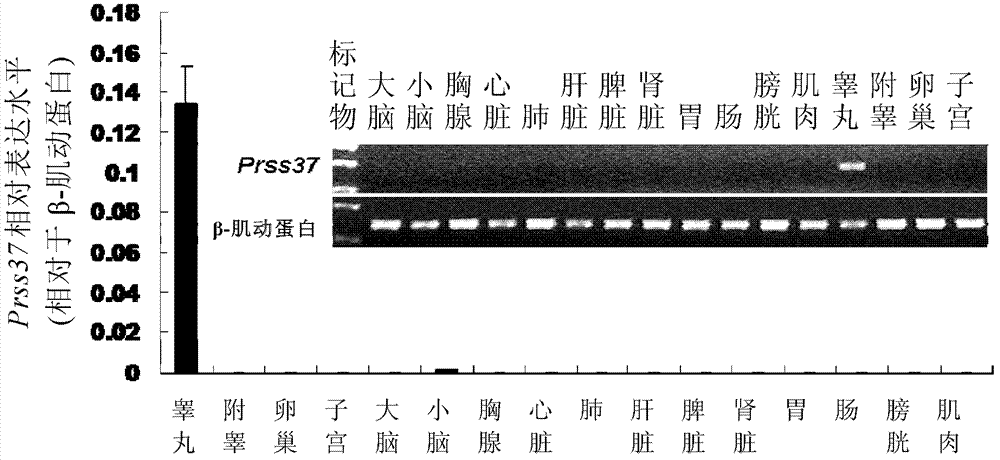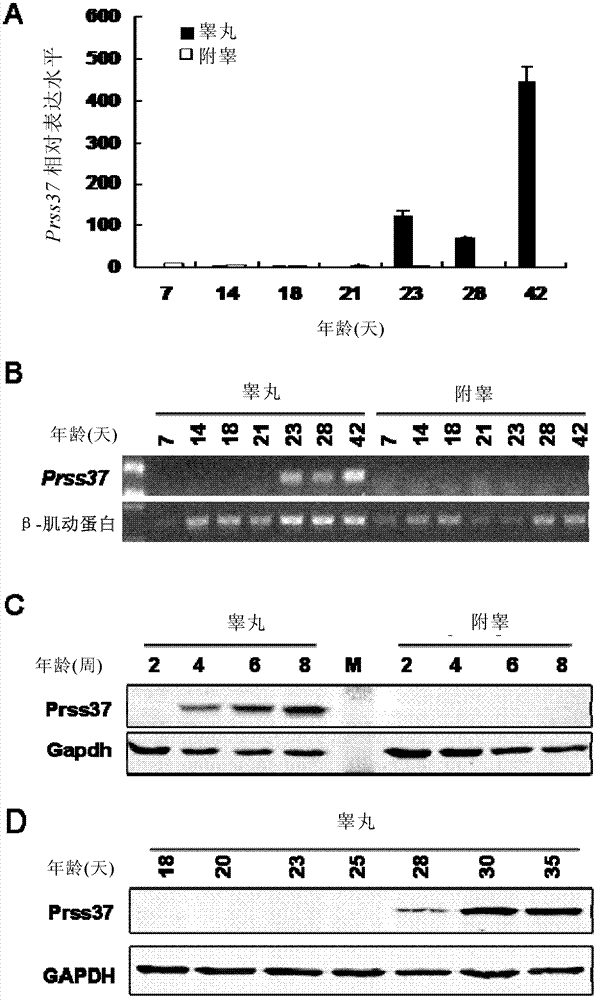Animal model with male reproductive disorders, as well as preparation method and application thereof
A fertility disorder and animal model technology, applied in biochemical equipment and methods, biological testing, microbiological determination/inspection, etc., can solve the problems of male mouse fertility decline, sperm-egg combination ability decline, and inability to complete the fertilization process, etc.
- Summary
- Abstract
- Description
- Claims
- Application Information
AI Technical Summary
Problems solved by technology
Method used
Image
Examples
preparation example Construction
[0109] Preparation of Prss37 knockout mice
[0110] The targeting vector was linearized with NotI and electroporated into SCR012ES cell line. Resistant cells were selected with G418 and ganciclovir. DNA was extracted from 128 clones, and positive clones with homologous recombination with the targeting vector were identified by PCR. The identification primers for the 5' and 3' homology arms were P1 (5'-CGAGCATCCTGGCTTATC-3', SEQ ID NO: 23), P2 (5'-CCACTCCCACTGTCCTTT-3', SEQ ID NO: 24) and P3 (5'- TTTATTAGGAAAGGACAGTGGGAGT-3', SEQ ID NO: 25), P4 (5'-TCTGTGAAGTAGGGATGGGTTGT-3', SEQ ID NO: 26), the PCR products are 5520bp and 4459bp, respectively. C57BL / 6J blastocysts were injected with two independent ES cell lines and subsequently transferred into pseudopregnant female mice to obtain chimeric offspring. The chimeric males were mated with C57BL / 6J females to produce heterozygous mice. All mice were housed in temperature-controlled cages, and the room was kept on a 12h day / 12h...
Embodiment 1
[0137] Tissue expression patterns and cell type-specific localization patterns of the Prss37 gene
[0138] cDNA samples were prepared by extracting RNA from 16 mouse tissues, including brain, cerebellum, thymus, heart, lung, liver, spleen, kidney, stomach, small intestine, bladder, skeletal muscle, testis, epididymis, ovary and uterus. Using specific primers for reverse transcription PCR and real-time PCR detection, it was found that a unique Prss37 transcript was specifically and highly expressed in testis tissue ( figure 1 ). By studying the testis and epididymis tissues of male mice at 7, 14, 18, 21, 23, 28, and 42 days after birth, it was further found that Prss37 gene transcription began in the testes of male mice at 23 days after birth, and began to be detected at 28 days after birth to the Prss37 protein. Neither Prss37 mRNA nor Prss37 protein was found in epididymis tissue, indicating that Prss37 protein was hardly present in spermatozoa in epididymis ( figure 2 )....
Embodiment 2
[0140] Preparation and Identification of Prss37 Gene Knockout Mouse Model
[0141] gene targeting strategies such as Figure 4 As shown in A, we deleted exon3 and exon4 of Prss37 gene by ET clone and ES cell homologous recombination, and replaced the deleted part with Neo resistance gene, in which the 5' homology arm was 4768bp long and the 3' homology arm was 3543bp long. Eight positive ES cell clones were identified by PCR method ( Figure 4 B). Two of these independent ES cell clones were used for blastocyst injection to obtain chimeric mice. Male chimeras were mated with C57BL / 6J female mice to obtain heterozygotes with mixed genetic background (129-C57). Three genotype mice conforming to Mendelian inheritance rules were obtained by mating heterozygous male mice and heterozygous female mice. And strictly from the DNA ( Figure 4 C), RNA ( Figure 4 D) and protein ( Figure 4 E-F) Levels for genotype verification.
PUM
 Login to View More
Login to View More Abstract
Description
Claims
Application Information
 Login to View More
Login to View More - R&D
- Intellectual Property
- Life Sciences
- Materials
- Tech Scout
- Unparalleled Data Quality
- Higher Quality Content
- 60% Fewer Hallucinations
Browse by: Latest US Patents, China's latest patents, Technical Efficacy Thesaurus, Application Domain, Technology Topic, Popular Technical Reports.
© 2025 PatSnap. All rights reserved.Legal|Privacy policy|Modern Slavery Act Transparency Statement|Sitemap|About US| Contact US: help@patsnap.com



